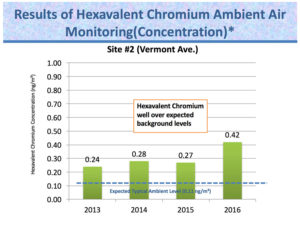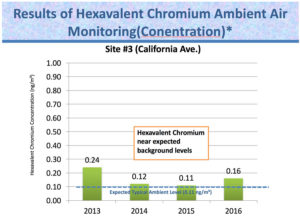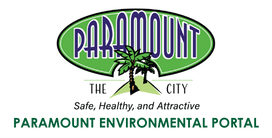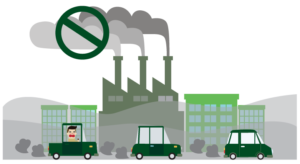The items listed on this page cover various claims that have emerged or have been brought to the public’s attention by numerous sources regarding the current hexavalent chromium issue. Each claim is clarified or expanded upon to promote full transparency and understanding. This page will be updated continuously, as new claims emerge or need to be addressed. If you have any questions, please feel free to contact us.
FACT:
When Paramount was incorporated as a city in 1957, it inherited land uses that the County of Los Angeles had put in place. All of the industrial zones in Paramount predate the City’s incorporation. Since then, the City has worked to continue making land use and zoning changes to remove many blighted and industrial uses. For example, when The Home Depot was added, this replaced a large swath of industrial property with commercial retail space. In addition, the City has worked to ensure that various uses match the appropriate zone. Since 1963, no new housing has been allowed to be built in the City’s core industrial area.
FACT:
The first the City learned about elevated levels of hexavalent chromium was when a reporter called the City seeking comment on a press release from the South Coast Air Quality Management District about elevated levels of hexavalent chromium being detected in the community.
Prior to that, the City had attended and monitored hearings and procedures related to Carlton Forge that started in 2013 and lasted through 2016. At those meetings, SCAQMD presented data on elevated metals in the air and developed a plan with Carlton Forge to address those air quality concerns. In presentations provided by SCAQMD at those meetings, elevated hexavalent chromium levels were never expressed as a significant concern, however they were elevated enough to warrant additional monitoring in the industrial sector of the city. SCAQMD charts showing average hexavalent chromium readings for years 2013, 2014 and 2015 indicated that hexavalent chromium levels near the normal ambient levels of hexavalent chromium in the area (as measured by the SCAQMD monitor in Compton, CA).


The data on these charts was presented to the City and community at a SCAQMD town hall meeting in August 2016.
FACT:
While the City may have the authority to revoke a business license, it has no legal authority to force a business to close without court action. The City would be required to seek a court injunction to shut down a business. The City would be required to show evidence to the court , such as: high level emissions of hexavalent chromium that are, at least, substantially, coming from that particular business in order for a court to grant the injunction. It is more challenging when a business demonstrates to the court that it is currently taking measures to comply with AQMD’ s abatement order. In December 2016, the LA County Department of Public Health and SCAQMD have already attempted to use the courts to shut down the activities at the Anaplex Corporation facility, and that efforts failed in the courts.
With AQMD’ s Order of Abatement, if these companies are not able to comply and they continue on as “repeat offenders,” the fines associated with shut downs and loss of revenue from being closed, could likely result in these companies closing on their own accord. The City’s hope with SCAQMD’ s regulatory process is that these companies make the necessary changes that results in clean air (i.e., no more illegal emissions) and continued operations and employment for their workers.
FACT:
When the South Coast Air Quality Management District (SCAQMD) began their investigation into the elevated levels of hexavalent chromium found by their long-term air quality monitoring efforts, the City of Paramount provided a list of metal-related businesses to assist the District in identifying the source of the carcinogen. Metal-related businesses were defined as: grinding, sanding, plating, electroplating, welding, deburring, heating, heat treating, straightening, forming, machining, cutting, rolling, pressing, forging, fabricating, polishing, milling, swaging, cooling, conversion coating, anodizing, passivation, and spray-coating operations.
This list, taken from Paramount’s permit database, contained 86 facilities located throughout the city. SCAQMD then added businesses of various types to this list of entities so as to inspect all facilities within their jurisdiction. These additions included businesses near Aerocraft Heat Treating and Anaplex Corporation, regardless of whether the business was metal-related, as well as businesses identified by community members who discovered these facilities primarily through Internet searches for metal-related businesses noted to be in the city. Further, the list grew as SCAQMD added facilities by identifying them through permits issued in Paramount for metal-related businesses. As a result of combining all these sources of information, the list of entities to be inspected grew to a total of 194 facilities and businesses. Hence, when SCAQMD states that they had investigated 194 businesses, this means that the District reviewed a list of 194 business entities that had been assembled from several sources and not all of which were metal-related.
Many of these 194 properties/businesses that were reviewed by SCAQMD were found to be either out of business, not located in Paramount, or not involved in metal-related activities. For example, SCAQMD and City Staff determined the following thirteen businesses were no longer operating: Hanks Sheet Metal, JM Metal Polishing, California Precision Deburring, Leavitts Metal Finishing, Luisteel Welding, Western Integrated Materials, Rosenberg Metals, United Sheet Metal, Aluminum Interior Moldings, El Tigre Metal Polish, Best Western Rolling, and E.S. Scales/Somerset Steel.
After extensive investigation, City Staff removed from the list all businesses that were not metal-related, any duplicate listings, and the entities that were no longer operating, listed above. The final number of metal-related facilities licensed to do business in Paramount totals 85, which amounts to 3% of total business licenses issued in the city. Of the 85 businesses, the City and SCAQMD determined that 68 of those businesses do not require SCAQMD permits for metal-related operations (examples include metal dealers, metal screw sales shops, metal supply shops, metal etching companies). To be clear, these businesses may have an SCAQMD permit for a backup generator or other equipment unrelated to metal processing.
The remaining 17 facilities require SCAQMD permits for metal-related processing (as of February 16, 2017).
To summarize: 194 names or locations were added onto a list assembled from multiple sources that was reviewed by SCAQMD; each name or address was investigated. After the investigation was completed, it was determined that there are 85 metal-related businesses in the city limits of Paramount. Of those 85 metal-related businesses, 68 do not require any permits from SCAQMD for metal-related processing. In total, 17 businesses do require SCAQMD permitting for metal-related work.
False.
The City always encourages residents to report any odor-related issues to AQMD, which investigates such reports. Call 1-800-CUT-SMOG
Regarding the effects of hexavalent chromium, upon learning about the significant environmental issues discovered by AQMD, the City partnered with AQMD to aid their investigation into finding the sources. The City also launched a significant public information campaign to keep the community informed about the air quality issues – including launching this website (paramountenvironment.org). Additionally, the City produced video updates for the community, purchased monitors to aid the search for emissions, and spoke at both the LA County Board of Supervisors and the AQMD Board to encourage more action and support for progress on air quality. Finally, the City formed a sub-committee to investigate the issue from a City viewpoint and advanced and adopted new zoning regulations designed to increase air quality and expand transparency of metal-related companies in the City.
False.
The City is vigilant about illegal parking issues, and conducts regular patrol checks in all areas of town. Residents have complained about truck parking at Carlton Forge Works (CFW) and the City has issued 41 citations since January of 2018. The City has also met with CFW management to explain City enforcement actions and expectations. This work included suggesting that CFW improve their delivery procedures to minimize the impact on nearby residents. The public is encouraged to report parking violations by calling (562) 220-2002
False.
Water Well 13 is not contaminated with cyanide. The latest water quality reports submitted and approved by the State Water Resources Board can be found here and show no measurable cyanide levels: https://paramountenvironment.org/annual-water-quality-reports/
The City performs regular testing of the water system as required by law. Should any negative results come about, the City will (in compliance with the law) inform the community about any negative health effects.
Water Well 13 is not shut down and is still operational, however, it is slated to be taken offline in the near future as part of a long-term strategy for the City’s water supply. The well is being replaced with a newer well that is deeper into the ground and uses newer equipment that is more energy efficient. Water Well 13 has outlived its expected life of 30-40 years and is due for replacement (it has been operating since 1978).
There was a history of manganese being present in the water at Water Well 13, and in 2003 the City implemented a filtration system to address these levels (see City Council presentation from 2003 here). Manganese is not a risk to public health, but it can damage pipes and discolor water. Mitigating the manganese requires the presence of an onsite backwash tank that is prominently located on the Water Well 13 property. There is no diesel fuel on the property or immediately adjacent to Water Well 13.
Water Well 13 testing during 2003 detected arsenic in the water supply, and this concern has been addressed on the website here: https://paramountenvironment.org/ufaqs/claim-paramounts-well-13-is-an-active-well-used-for-drinking-water-and-contains-high-levels-of-arsenic-above-the-environmental-protection-agencys-epa-maximum-contaminant-level-mc/.
FACT: SCAQMD removed monitors in Paramount due to safety issues for their employees related to the pandemic. There is, though, one multi-metal monitor still operating in town that takes hourly readings of many different metals; its data is regularly read remotely by SCAQMD staff. SCAQMD has told the City that recent levels of metals from this monitor have been unremarkable and consistent with average levels observed in 2019/2020. SCAQMD is hoping to get its employees vaccinated soon but has offered no timeline. The City of Paramount does not feel it has the right to demand how another agency deals with its employees, especially in areas of personal health.
FACT: In regards to Irvine, SCAQMD has explained that the monitoring done there is VERY different than the filter-based monitoring in Paramount. In Irvine, the testing is for volatile organics, a process that does not involve a lot of human contact so their employees do not need to interact very much with one another. In Irvine it is a long-time asphalt plant that is emitting the odors, and in October 2020 the City Council directed their Police Department to explore revoking the company’s business license. An Irvine official recently confirmed to Paramount City staff that, after reviewing the matter with SCAQMD, the City has found it does not have the ability to revoke the business license, and Irvine is now working collaboratively with AQMD to monitor the situation and provide the community with information. This is exactly what happened in Paramount in 2016, and Paramount continues its efforts to contain any ill effects related to these issues.
FACT: The Environmental Working Group (EWG) is a national non-profit environmental group whose goal is to convince the Federal Environmental Protection Agency (EPA) to lower the safety thresholds for certain natural and unnatural compounds found in water. As such, EWG has created a database listing what they feel the new standards should be for the safe levels of these compounds. That is where the arsenic figure for Paramount comes from. Many water-quality experts, however, feel EWG’s standards are deeply flawed and unrealistically low, and that current regulations are scientifically based to reflect permissible levels. The City of Paramount’s water supply is tested constantly and continually meets all State and Federal regulations. With arsenic, specifically, California’s Drinking Water Division limits it to 10 parts per billion, and Paramount’s water has less than eight parts per billion. For any questions regarding water quality in the City, please call (562) 220-2020.
Claim: Paramount has threatened to sue people who question its water quality … but at this meeting Paramount staff admitted that the water is contaminated and they couldn’t explain the testing numbers.
Fact: The City has, on very rare occasions, threatened to sue those who have spread baseless misinformation about the water supply system that could produce panic and fear in water customers.
Claim: A City staff member said that the aquifer where Paramount gets some of its water doesn’t respect city boundaries, that the cities of southeast LA. County get water from the same aquifer. In light of this, Paramount’s claim to have low PFAS in the water doesn’t make sense since surrounding cities like Downey have warned its residents about high PFAS contamination levels. If water in Downey is not safe, how can Paramount’s water be safe?
Fact: It is true that aquifers don’t respect city boundaries. How could they? But claiming that our testing numbers are inaccurate due to that fact is erroneous. Paramount’s PFAS numbers were detected at small concentration levels, and all of this testing is done by independent labs, who submit their findings to the State. Only after gaining approval from the State does the City receive and publish the results.
The City’s Consumer Confidence Report notes that the level of PFAS found in our water was two parts per trillion. This number represents a combined average from all three of Paramount’s active wells. That is how the State’s Drinking Water Division calculates overall numbers for a water system, using averages.
In reality, only one well in town contained PFAS – the other two had zero detection. The one well tested at 7.9 parts per trillion for PFAS, which is slightly above the 6.5 parts per trillion level that requires public notification. This is still a very low amount that does not necessitate any action. Regardless, out of an abundance of caution, the City shut down that well in 2020; it is still not operating.
Claim: Staff says they are not scientists, so they can’t answer why the testing numbers in Paramount’s water are much lower than the contaminated water in Downey. But if they are not scientists, how can they be so confident that the water is safe?
Fact: The City relies on scientists at the State Water Quality Control Board, Drinking Water Division for compliance of permit requirements, including water quality monitoring and lab analysis from independent labs approved by the State. Those labs, and the State of California, have consistently found that Paramount’s water meets all water quality standards and is safe for all uses.
FACT: The monitor in question has, in fact, NOT been finding unusually high levels of hexavalent chromium, and certainly not at levels anywhere near 40 times the norm. This has been confirmed by both the resident who delivers the raw data to the lab for processing and a spokesperson for the Center for Environmental Health. This can be seen in the results posted on the Center for Environmental Health’s website.

